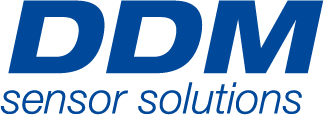
DDM pressure sensors –output signal – digital or analogue
Select the right output signal / interface for your specific application and task.
DDM Experts Knowledge “Asked – Known!”
What types of interfaces are there for pressure sensors, what are their advantages and disadvantages and areas of application?
Overview of Pressure Sensor Interfaces
Pressure sensors are critical components in a wide range of applications, from industrial processes to consumer products. A key component of their functionality is the type of interface they use. The following details the most common types of interfaces, how they function, and their advantages and disadvantages.
Analogue output signal
Types (e.g. 4-20 mA, 0-10 V, 0-5 V, 1-6 V, 0.5-4.5 V)
- 4-20 mA:
- Standard in industrial applications
- Offers very high noise immunity
- Live-Zero feature means 4 mA must flow when there is no pressure, allowing for wire break detection (0 mA = wire break)
Application:
In the process industry, 4-20 mA interfaces are often used to monitor pressure in pipelines. The robust and straightforward nature of this interface makes it ideal for long cable runs and harsh industrial environments where precise and reliable pressure measurements are crucial.
- 0-10 V, 0-5 V:
- Simple integration
- Low power consumption of 3 mA
- Standard in laboratories
- Experimental measurement technology for research and development
- 1-6 V:
- Simple integration
- Low power consumption of 3 mA
- Standard in laboratories
- Experimental measurement technology for research and development
- Live-Zero feature means 1 V must be present when there is no pressure, allowing for wire break detection (0 V = wire break)
- 0,5-4,5 V:
- Simple integration
- Low power consumption of 3 mA
- Live-Zero function means 0.5 V must be present when there is no pressure, allowing for wire break detection (0 V = wire break)
Application:
These interfaces are predominantly used in miniature sensors because they require fewer electronic components. This reduces the size and increases the lifespan under high-temperature loads. They are often used in applications with high-temperature stress up to +150°C, such as in vehicle measurement technology, aviation, or the military.
- 0,5-4,5 V (ratiometric):
- Simple integration
- Low power consumption of 3 mA
- Live-Zero function means 0.5 V must be present when there is no pressure, allowing for wire break detection (0 V = wire break)
A ratiometric pressure sensor does not contain an internal voltage regulator. It can be operated with an unregulated DC voltage of 5 V. This saves the user the cost of a stabilized DC power supply. The output signal of the pressure sensor changes in the same ratio (ratiometrically) to the change in supply voltage. By measuring the current supply voltage, the output signal is corrected.
Application:
A typical application for a ratiometric pressure sensor is a battery-powered data logger in field use. The data logger provides a supply voltage of about 5 V for the pressure sensor. Over time, the supply voltage drops. The actual value of the voltage (<5 V) is measured, and the output signal of the pressure sensor is corrected accordingly.
Functionality
- All types convert the measured pressure into a proportional electrical signal.
Advantages
- Simple implementation: Easy to understand and integrate.
- Robust against interference signals: Especially with 4-20 mA, suitable for long cable distances.
Disadvantages
- Limited data complexity: Can only transmit simple pressure values.
Digital Interfaces
Types (e.g., I2C, SPI, UART)
- I2C: Two-wire interface, ideal for short distances.
- SPI: Fast, but requires more lines.
- UART: Simple, often used in microcontroller-based systems.
Functionality
- All types transmit data in a binary format, which allows for the transmission of more complex and accurate data.
Advantages
- High data precision: Enables accurate measurements.
- Flexibility: Suitable for smart devices and IoT applications.
Disadvantages
- Complexity: Requires more complex integration and programming.
- Limited range: Especially with I2C and SPI.
Application:
Digital interfaces such as I2C are often used in consumer electronics, for example in smartwatches for measuring blood pressure. The compact size and low power consumption of these sensors are perfect for wearable devices that need to capture precise pressure data.
Fieldbus Interfaces
Types (e.g., Profibus, Modbus)
- Profibus: Widely used in automation technology.
- Modbus: Simple to implement, versatile.
Functionality
- All types allow communication among multiple devices over a common bus system.
Advantages
- Network capability: Enables integration of many devices.
- Flexibility and scalability: Easy to expand the network.
Disadvantages
- Complexity: Requires more comprehensive planning and installation.
- Cost: Often more expensive to set up than simpler systems.
Application:
Modbus interfaces are used in building automation, for example, in monitoring air pressure in air conditioning systems. Their capability to communicate with multiple devices enables centralized control and monitoring of air conditioning systems in large buildings. This allows for efficient management and ensures consistent environmental conditions throughout the facility.
Wireless Interfaces
Types (e.g., Bluetooth, Wi-Fi)
- Bluetooth: Low energy consumption, ideal for mobile applications.
- Wi-Fi: : Higher data rates, suitable for more demanding applications.
Functionality
- All types transmit data wirelessly, which allows for flexible installation and remote monitoring.
Advantages
- Flexibility: No cables required, easy installation.
- Remote Access: Enables monitoring from a distance.
Disadvantages
- Security Risks: Vulnerable to hacking and interference.
- Range and Reliability: Limited compared to wired systems.
Application:
Bluetooth pressure sensors are often used in medical technology for wireless blood pressure monitors. These devices allow patients to monitor their blood pressure conveniently at home and transmit the data wirelessly to their smartphones or doctors.
HART Protocol
Functionality
- Combines analog signals (4-20 mA) with digital signals, allowing for two-way communication and data acquisition.
Advantages
- Backward compatibility: Can be used in existing 4-20 mA systems.
- Enhanced data transmission: Enables the transfer of diagnostic and configuration data.
Disadvantages
- Complexity: Requires specific knowledge for setup and maintenance.
- Speed limitation: Slower data transmission compared to purely digital interfaces.
Application:
The HART protocol is used in refineries to monitor the pressure in distillation columns. The combination of analogue reliability and digital communication makes it possible to perform accurate pressure measurements and device diagnostics.
IO-Link
Functionality
- It is a point-to-point communication system used for connecting intelligent sensors and actuators to an automation system.
Advantages
- Easy integration: Standardized interface allowing simple and cost-effective cabling.
- Data access: Provides access to device data and facilitates easy configuration and diagnostics.
Disadvantages
- Range: Limited cable distance, typically up to 20 meters.
- Specific hardware required: Not all control systems support IO-Link.
Application:
IO-Link is used in automated production, for example for pressure control in pneumatic systems. Thanks to its simple integration and communication, IO-Link enables efficient and flexible control of manufacturing processes.
RS232
Functionality
- A serial communication interface used for point-to-point connection between devices.
Advantages
- Widespread use: Long established in the industry, many devices are compatible.
- Simple implementation: Low complexity and ease of use.
Disadvantages
- Limited cable length: Not ideal for long distances.
- Slower data transmission: Not suitable for applications requiring high data throughput.
Application:
RS232 interfaces are often used in laboratories for precision pressure measurement devices. They enable simple and direct data transfer to computers for analysing and recording pressure data.
RS485
Functionality
- A serial interface for longer distances and higher speeds compared to RS232.
Advantages
- Long distances: Suitable for transmissions over several kilometers.
- Multiple devices: Supports up to 32 devices in a network.
Disadvantages
- Complexity: Requires careful planning in network configuration.
- Shielding necessary: Sensitive to electromagnetic interference.
Application:
RS485 is suitable for industrial control systems, such as in water treatment plants. The ability to communicate over longer distances makes RS485 ideal for monitoring pressure levels in widely distributed systems.
CANopen
Functionality
- A communication protocol based on the CAN (Controller Area Network) bus, optimized for automated control systems.
Advantages
- Robust and reliable: Ideal for harsh industrial environments.
- Real-time capability: Suitable for time-critical applications.
Disadvantages
- Complexity: Requires specific knowledge for configuration and diagnostics.
- Limited data rate: Not suitable for applications with very high data throughput.
Application:
In the automotive industry, CANopen is used to monitor hydraulic pressure in production systems. Its robustness and real-time capability are crucial for maintaining production quality and safety.
J1939
Functionality
- A protocol based on the CAN (Controller Area Network) bus, specifically developed for heavy-duty vehicles and industrial applications.
Advantages
- Standardized: Specially designed for commercial vehicles and mobile applications.
- Robust: Suitable for harsh environments and heavy-duty use.
Disadvantages
- Specific to the vehicle industry: Limited use outside this sector.
- Specialized hardware required: Not universally applicable.
Application:
J1939 is used in heavy commercial vehicles to monitor tyre pressure. This protocol is specially designed for vehicle applications and enables reliable monitoring under harsh conditions.
LoRaWAN
Functionality
- A low-power wireless network protocol, ideal for IoT applications and remote monitoring.
Advantages
- Wide range: Kilometer-long transmissions with low energy consumption.
- High network capacity: Supports thousands of end devices.
Disadvantages
- Limited bandwidth: Not suitable for data-intensive applications.
- Latency: Not suitable for real-time applications.
Application:
LoRaWAN is used in agriculture to monitor soil pressure in large fields. The long range and low energy consumption are ideal for this type of remote monitoring.
Bluetooth
Functionality
- A widely used wireless technology for data transmission over short distances.
Advantages
- Low energy consumption: Especially with Bluetooth Low Energy (BLE).
- Wide compatibility: Supported by many mobile devices and computers.
Disadvantages
- Limited range: Effective only over short distances.
- Interferences: Susceptible to disruptions in crowded radio areas.
Application:
Bluetooth pressure sensors are used in healthcare technology for wireless blood pressure monitors, allowing patients to monitor their blood pressure in the comfort of their own homes and transmit the data wirelessly to their smartphones or directly to medical staff, improving patient care and monitoring.
Conclusion on selecting the right interfaces for pressure measurement
Choosing the right interface for pressure sensors depends heavily on the specific application and environmental conditions. Each interface offers unique advantages, whether in terms of range, data transmission speed, energy efficiency or robustness. This comprehensive overview is intended to help you find the right interface for every application.

